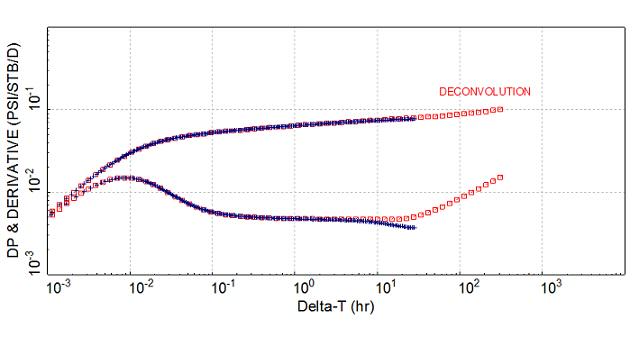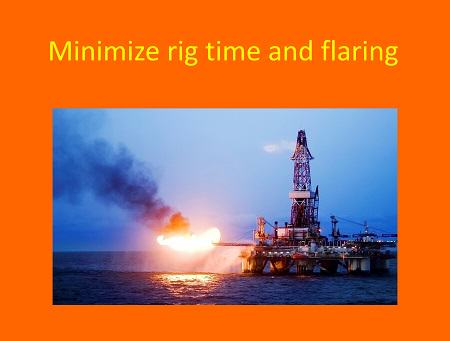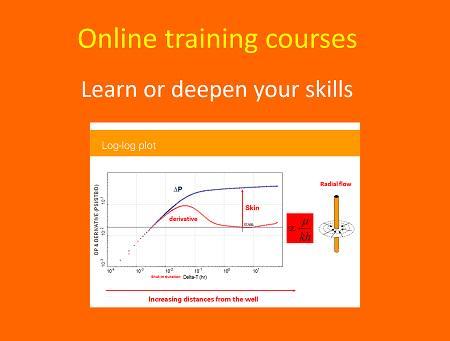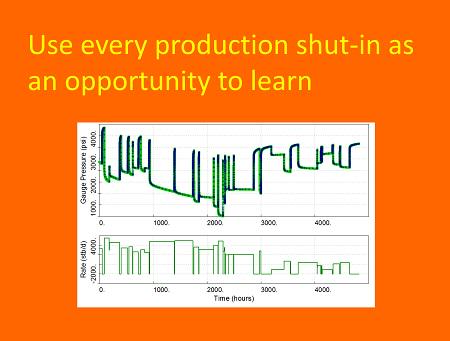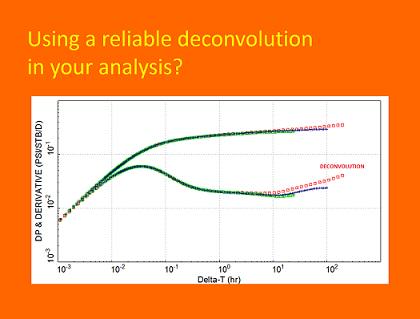Using a reliable well test deconvolution in your analysis ?
The Deconvolution technique transforms variable rate and pressure data into a constant-rate initial drawdown pressure response with duration equal to the duration of the entire test.
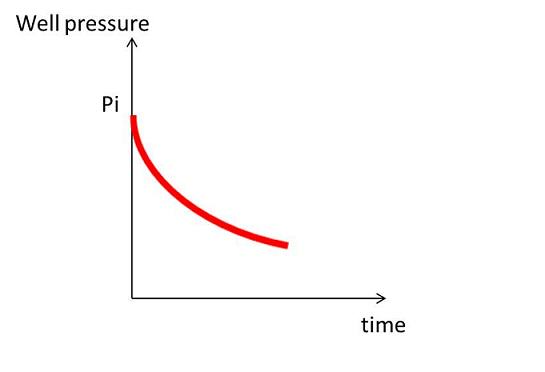
Plotting this response and its derivative with respect to the log of Δt versus the test duration Δt on a log-log scale gives the deconvolved response, as shown in red in the figure below.
The duration of the deconvolved derivative plot is equal to the entire test sequence, from production start-up to the time when the PBU test is performed.
Some benefits
The deconvolved derivative could be seen as an “improved derivative”:
-
-
The response is free from any distortions (errors) that are caused by the conventional derivative calculation algorithm. As a result, it provides a better identification of the different flow regimes over time.
-
-
-
The deconvolved derivative is defined over a longer time interval than the original PBU duration. It therefore provides additional reservoir insights and may help to support radial flow regime in the horizontal plane, as well as the presence of boundaries. It also provides technical evidence for increasing minimum connected volume.
-
Deconvolution helps to refine initial pressure and on some occasions can also help to shorten the PBU test (we need to be cautious when shortening a test, in particular as production time increases).
-
Deconvolution can be applied to brand new wells to improve the understanding of the pressure transient response. But pressure data from more mature wells can also be re-assessed with deconvolution so as to provide new clues and to challenge previous interpretation.
As any other tools, deconvolution has some limitations
It is worth noticing that deconvolution has some limitations and may not be correctly derived.
For deconvolution to be valid, a number of conditions needs to be reached, such as single phase flow in the reservoir or sufficient PBU test duration. Before using deconvolution as part of the well test analysis toolkit, it is therefore critical to confirm its validity, and this needs a bit of expertise.
Do you use a reliable deconvolution in your analysis ?
More on deconvolution and know-how in the library in the learning centre. To access the library, you need to join the Well Testing Group.
Well Test Deconvolution
Quicklook review of design or analysis
Simply send us your presentation or report via the
Secure File Transfer.
We will send you our comments, explain what could be missing, improved or better explained, and what other solutions are possible.
For a more detailed analysis, please send us more data. Check out the Input Needed.
Get the most out of your data !
Join the Well Testing Group
Place where members can learn, share case studies & best practices and challenge each other.
Receive information on well test design and analysis and join-in to audio teleconference sessions.
Get access to more resources, ideas and help with our library.
Why testing wells ?
Exploration, appraisal, development
- Confirmation of discovery and productivity
- Clean-up and rate measurement
- Large volume fluid sample
- Well and reservoir performance
- (skin, KH, Pi, heterogeneity, boundaries)
- Reservoir connectivity & proven volume
- Flow behaviour around wellbore
- Large scale of investigation (100-1000s ft)
Production and injection
- Use of opportunistic shut-ins
- Track permeability, skin, reservoir pressure
- Monitor performance over time
- Understand performance deviation
- Assess well intervention
- Quality control rate measurement
No alternative
No other alternative to:
-
obtain large fluid sample
-
evaluate permeability over large distances (~100s-1000s feet),
-
assess well damage (skin)
-
investigate connectivity over large volume
Why using our services?
Global Experience from Explo to Production
Extensive experience from Exploration to Production, in all types of wells and reservoirs worldwide.
Expertise in deconvolution
We have expertise in deconvolution.
Deconvolution is a great asset for your team. It helps to improve the understanding of the pressure data, refine initial pressure and add reservoir insights. While deconvolution is not new, it is often misused in the industry.
We are also dedicated to coaching you with deconvolution.
Dedicated to you !
We can act as your team well test expert, provide a 2nd review or simply reduce your expert’s workload.
We can review data from your shut-in or active wells with or without downhole gauges.
Maximum value
With costly and rare shut-in pressure data, don’t compromise on its interpretation.
We guarantee to provide more value out of your data. Let’s try a quick review of your existing design or interpretation and we’ll send you our comments.
Get a 2nd opinion
You already have a design or interpretation study but are not entirely satisfied or simply want to check if more value can be obtained at minimum cost?
Get a second review from us.
Our clients
We support geologists, petrophysicists, engineers from national companies, independents, majors and more “generalist” service companies.

